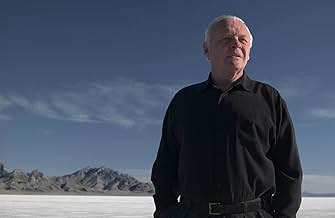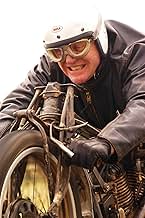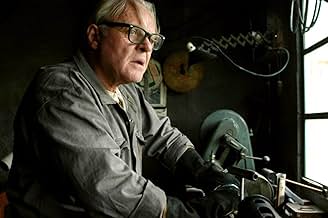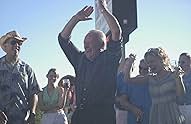Die Geschichte des Neuseeländers Burt Munro, der Jahre damit verbringt, ein indisches Motorrad von 1920 zu restaurieren. Schließlich gelingt es ihm mit dem Motorrad, 1967 in den Bonneville S... Alles lesenDie Geschichte des Neuseeländers Burt Munro, der Jahre damit verbringt, ein indisches Motorrad von 1920 zu restaurieren. Schließlich gelingt es ihm mit dem Motorrad, 1967 in den Bonneville Salt Flats in Utah den Landgeschwindigkeitsrekord zu brechen.Die Geschichte des Neuseeländers Burt Munro, der Jahre damit verbringt, ein indisches Motorrad von 1920 zu restaurieren. Schließlich gelingt es ihm mit dem Motorrad, 1967 in den Bonneville Salt Flats in Utah den Landgeschwindigkeitsrekord zu brechen.
- Auszeichnungen
- 11 Gewinne & 6 Nominierungen insgesamt
Empfohlene Bewertungen
The main character, New Zealander Bill Munroe as played by Anthony Hopkins, is a true man's man. He has spent his entire adult life tinkering with his streamlined motorcycle, a 1920 Indian (hence the title.) Now in his 60's in the year 1963, he wants to realize his life's dream of taking it halfway around the world to the Bonneville Salt Flats Test Track in Utah, the only place where he can find out how fast it will actually go.
The movie pulls off two often-used themes, The Long Journey and Overcoming Adversity, without a hint of phoniness or melodrama. The Long Journey from New Zealand to Utah takes up most of the movie, with Munroe scrounging up travel money, working off part of his passage on a dilapidated freighter, and the long, event-filled drive from the California coast to Utah in an old used car. Overcoming Adversity is portrayed in two ways: by Munroe's awesome mechanical genius as shown by his ability to fashion spare parts out of almost anything and to improvise a la MacGyver, and in his charm and likability when confronted with more human obstacles. Indeed, one of the movie's chief strengths was the character's ability to make friends easily under any situation, with a cast of colorful supporting characters who wonderfully complemented Hopkins' acting.
After finally reaching the test track, the movie's focus shifts from the acting to the cinematography and drama. The dozens of colorful cars, motorcycles, and drivers' outfits contrast strikingly with the blinding white of the salt flats and the mountainous backdrop. And when Munroe finally gets the chance to make his test run, two questions come to mind. How fast can he go? More importantly, will the 64-year-old man and the 43-year-old patched-up bike hold together under the strain?
After seeing the movie and while still in my euphoric state, my skeptical mind wondered how much of it was actually true. I did a little research, and the portrayal of this amazing man seems to be true enough. Go see this movie; if you do, you'll leave the theater feeling good, and perhaps even a little inspired.
Seriously, I am a motorcycle aficionado but I truly think this movie transcends that. It's not a "guy's film" at all but a serious look at the life of a man that was average by his own reckoning - by ours he's a hero. When you find yourself looking at that and saying "I would have quit" and it was only the beginning of the movie, well, that's some tough stock Burt Munro came from.
And it's not tedious, not an uphill struggle all the way against insurmountable odds, none of those clichés. It's a great movie about a real guy and I can't imagine someone watching it and not being entertained, moved, and frankly, impressed.
At a sneak preview of this movie in Burt Munro 's hometown - Invercargill, I noticed at the end that many of the men had moist eyes -not that the film is weepy or sycophantic in any way - it's simply inspirational.
The hero/underdog here is a social misfit, a self-confessed dirty old man but a lovable one. He loves the ladies and he loves speeding on his vintage Indian Scout "modified somewhat" along the open beach of Invercargill in Southern New Zealand. Beach bike racers still contest the Burt Munro Trophy on Oreti beach.
Burt's 1967 record at Bonneville still stands.
Anthony Hopkins manages the problematic Kiwi accent well to deliver a touching, funny and realistic depiction of Burt in his quest to be the fastest thing on two wheels. Sir Anthony said that it's the best thing he's ever done and it's hard to disagree based on his laconic and lovable portrayal.
Outstanding cameos by the likes of Annie Whittle and Diane Ladd simply add depth and verisimilitude to the film. Tim Shadbolt, well he definitely acted in the film...
Complete and convincing performances that warm the heart and show true humanity shining through.
The cinematography is clear and precise, the action scenes are mercifully free of special effects and Burt's kiwi innovation and guile win the day.
A new classic from Roger Donaldson.
This film reminded me of "The Straight Story," starring Richard Farnsworth. That dealt with an old man taking a long tractor ride across the state of Iowa to see his dying brother. It featured a bunch of nice characters he met along his journey. This is much the same as we witness Munro's encounters with a variety of people in the United States. Like "The Straight Story," all the people are good people and help our man. That's nice to see.
Once he finally gets to the Salt Flats, however, his problems are far from over as he is unable to meet any of the minimum safety standards. It appears he made his trip for nothing, but, you'll see what happens if you view this movie.
New Zealanders say Hopkins did them proud, too, and they would know if he did a good job or not playing a man from their area of the world, whether he sounded and acted realistically. They say he did.
I enjoyed the first 35 minutes of this story the most. Maybe because that's the most innocent part of the film and features a young boy who looks up to Burt and encourages him when few others are willing to do so.
It's when Munro reaches America where the "nice, clean family film" goes south a bit. He hooks up with transvestites, one-night stands, profanes here and there and the PC angle gets a little overplayed. However, despite making America look a little too weird, everything is done is a tasteful way and it still was a wonderful story. It has to be an inspiration for older folks who might think life's challenges are over once they hit a certain age. Not so, as Mr. Munro shows us in this inspiring, well-photographed film.
This certainly is quite an unknown movie for one which has such a famous actor in the starring role. It's well worth your time, though, to check out.
Wusstest du schon
- WissenswertesBurt Munro's children visited the set one day, when, according to writer, producer, and director Roger Donaldson, "Tony (Sir Anthony Hopkins) was having a particularly good Burt day." His performance was so authentic that it moved them to tears.
- PatzerBurt talks about his twin brother and tells Tom a story about how he died as a youngster. The real Burt Munro had a twin sister who died at birth.
- Zitate
Tom: Aren't you scared you'll kill yourself if you crash?
Burt Munro: No... You live more in five minutes on a bike like this going flat out than some people live in a lifetime.
- VerbindungenFeatured in The Daily Show: Anthony Hopkins (2006)
- SoundtracksYou Are My Sunshine
(Jimmie Davis / Charles Mitchell)
© Peer International Corp
Used by permission. All rights reserved
Top-Auswahl
Details
- Erscheinungsdatum
- Herkunftsländer
- Offizieller Standort
- Sprache
- Auch bekannt als
- El amo del viento
- Drehorte
- Produktionsfirmen
- Weitere beteiligte Unternehmen bei IMDbPro anzeigen
Box Office
- Budget
- 25.000.000 $ (geschätzt)
- Bruttoertrag in den USA und Kanada
- 5.128.124 $
- Weltweiter Bruttoertrag
- 18.302.013 $
- Laufzeit
- 2 Std. 7 Min.(127 min)
- Farbe
- Sound-Mix
- Seitenverhältnis
- 2.35 : 1


























